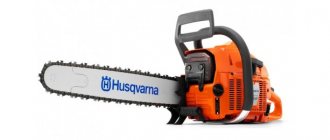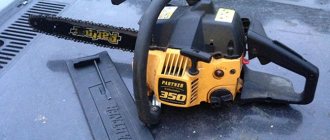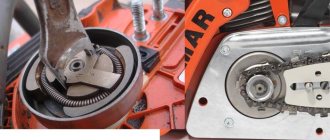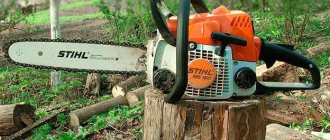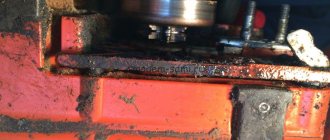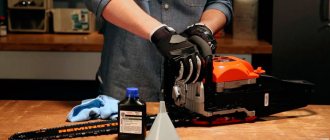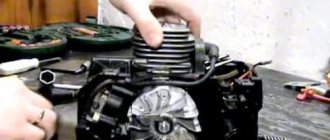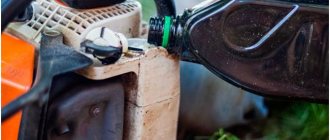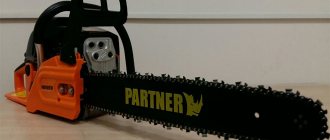Operational features
When operating a Husqvarna 142 chainsaw, its features must be taken into account. This is a simplified semi-professional model, not intended for everyday long-term use. The main scope of the Husqvarna chainsaw is gardening and dacha work and the housing and communal services sector - pruning large branches, felling dried trees, etc.
Husqvarna 142 chainsaw device
The power plant is a two-stroke carburetor engine with a working volume of 40 cm3 and a power of 2.58 liters. with., air-cooled. It runs on a gasoline-oil mixture in a ratio of gasoline to oil as 50:1.
During operation, Husqvarna branded oil is required, but in the absence of such, the manufacturer allows the use of any high-quality engine oil, but in a different ratio - 33: 1.
The Husqvarna chainsaw features a minimum of controls - there is only a switch, a choke position lever and a combined throttle control lever. The primer, i.e., the fuel suction button, is absent for this model, which complicates starting, but facilitates troubleshooting.
A feature of the Husqvarna chainsaw is the recommended mode of its operation - at high, not at low speeds.
Operational qualities allow sawing dry and damp wood of various species, including hard ones such as oak and beech. In general, the Husqvarna 142 chainsaw is characterized by high build quality, unpretentiousness and reliability. Malfunctions in operation are rare and are mainly associated with improper carburetor adjustment or failure of consumables.
Benefits of Husqvarna chainsaws
Classic layout
The classic Husqvarna layout makes it easy to repair your chainsaw yourself. The headset with the saw chain is located on the right and side of the saw, the emergency brake is also located there. The auxiliary handle covers the engine housing from left to right. The on-off button is located at the back and is oriented under the thumb, the clamped accelerator key is on the handle.
The drum and starter handle are located on the left, above the cooling grate. Bottom left is the fuel tank cap.
All elements of the mechanism are hidden under the cover of the case.
Husqvarna 142 layout
Most common problems
The most common Husqvarna chainsaw problems include:
Chainsaw ignition system
- improperly adjusted carburetor;
- malfunction of the ignition unit;
- fuel block malfunctions;
- unadjusted clutch mechanism;
- oil system malfunctions;
- incorrect starter operation.
These problems lead to malfunctions of the chainsaw.
The saw does not start or stalls after pressing the accelerator. Possible reasons are a breakdown of the starter (in this case, it is not repaired, but replaced with a new one), contamination or breakdown of the elements of the ignition system, malfunction of the spark plugs or coil. Most often, candles fail. Another option is difficulty in supplying fuel, most likely a clogged fuel filter or a pinched fuel hose from the tank to the carburetor. Fuel tank breather may be clogged.
Difficult start, appearance of white smoke. The cause of these malfunctions is an incorrectly adjusted carburetor, supplying too little or too much fuel mixture, or preparing it in the wrong proportion. A sign of this is white smoke from the engine compartment.
Chainsaw start sequence
Scrolling the chain when idling. Causes of malfunction: unadjusted or failed clutch mechanism, unadjusted idle speed, air leaks into the carburetor or crankcase.
Chainsaw chain device
Saw chain lubrication problems. They are expressed in the absence of lubrication or the chain coming out in a dirty state. The causes of this malfunction are various - a breakdown of the oil pump, blockages in the breather (hole in the oil tank cap) oil channel or filter, or a malfunction of the oil drive gear.
Husqvarna chainsaw chain lubrication system
How to Assemble a Starter on a Husqvarna Chainsaw
Chainsaw starter. Learning to repair ourselves
To quickly start any chainsaw, a starter is required. With accelerated scrolling of the crankshaft of the tool, the fuel-air mixture supplied to the engine is compressed and then ignited. Therefore, the normal operation of the starter for a chainsaw determines the performance of the entire mechanism.
Launcher Devices
Almost all leading manufacturers of chainsaws complete their products with starter motors of a similar principle of operation. It is no coincidence that specialized stores offer universal starter designs that are equally suitable for Shtil, Huskvarna, Makita chainsaws, as well as for Chinese semi-official fakes for the named trademarks. Some features. these are just starting home chainsaws (Forester, Urals and a number of others).
The principle of a chainsaw starter is as follows. In the groove of the housing there is a handle through which the cable passes. If the handle is raised sharply, the cable is pulled out and the ratchet drum is turned on, which transmits the movement to the drum using the splines provided on the shaft. In this case, the crankshaft performs several revolutions, and the working mixture in the space between the piston and the cylinder head is compressed. Accordingly, when the handle is lowered, contact between the ratchet and the splines is lost and the shaft stops.
READ Chainsaw Running at High RPM
As engine power increases, the required amount of fuel-air mixture required for post-ignition increases, so the number of jerks due to the starter cable for heavy-duty saws increases. Therefore, in order to speed up the return of the drum, forced return springs made of steels with high elastic properties are used.
The easiest way to start a chain saw is in the following ways:
- Pre-enrichment of the working mixture, for which the design of the carburetor has a special damper.
- Installation of an automatic decompression valve that reduces the operating pressure in the chainsaw.
- Installation of an additional spring, which during the movement of the cable facilitates the unwinding of the crankshaft.
- The presence in the design of some chainsaws (for example, Partner Series S, Maxcut, etc.) of a priming pump that provides fuel pre-pumping.
Husqvarna 236/240 chainsaw starter spring replacement
The spring installation and assembly process is shown. starter
chainsaw
Husqvarna
(
Husqvarna
).
Spring, coil and starter
.
Starter chainsaw repair (broken spring)
Simple chainsaw repair for beginners
own hands.
Chainsaw repair
With frequent starting of the chainsaw, some parts of the starter are constantly subjected to dynamic loads. As a result, the cable may break, a few trembling teeth may fall off, and the shaft will rotate at a much slower speed. Therefore, the revision and even repair of the starter. these are operations that are sometimes performed several times in a season.
READ Stihl 361 Chainsaw Disassembly
Cord replacement
When it's drawn, the cable is constantly shaking off the starter housing. To replace, remove the assembly housing and carefully lift the ratchet drum so that the spring does not jump out of its socket. It is better to do this work: the assistant fixes the spring, and the cable is replaced. After fixing the cable in the handle and in the grooves of the drum, the cable is wound on the roller, and the body is assembled.
Spring renovation
If the starter spring material was not of good quality, the spring breaks (usually at the point where it joins the drum where it forms a loop). There is no need to replace the spring in this case. It is enough to thoroughly clean the surface of dirt and grease, carefully polish the place of destruction, and then release the spring at 600.650 ° C (steel springs should turn crimson). It is necessary to cool the spring slowly and at 100.150 ° C it is already possible to carefully wrap its end in the form of a restrictive ledge on the inner surface of the drum (the steel acquires the necessary plasticity) and insert it into place. The elastic properties of the spring will not change.
How to put a spring on a chainsaw starter?
Place the starter spring in the right slot. it is not easy even for an experienced user. Initially, the spring must be twisted to the previous diameter and installed in the cavity of the drum hub. The outer end of the spring is fixed by a restrictive ledge, and the outer end of the spring is located opposite the hole in the lock. Loop at the inner end of the spring. it is a screwdriver combined with a hole, after which the disc is lowered. Disc rotation is checked to make sure the ratchet pawl is in place. Next comes the assembly of the ratchet mechanism itself.
READ Which Oil is Best for Chainsaw Chain Lubrication
After installing the spring, it is necessary to adjust the tension. To do this, a cable is inserted into the groove along the perimeter, and a return spring is wound around it. After removing the slack, it is best to tighten the spring a few more turns to ensure the required tightness of the part.
Repairing a ratchet at home is not recommended as many operations require the use of a CNC machine. It is easier to buy a new node in specialized stores.
Troubleshooting and do-it-yourself repairs
Repairing a Husqvarna chainsaw is complicated by the fact that it requires specific tools that are usually not included in the arsenal of a home master. But all of them can either be bought at an auto parts store or made by hand.
Husqvarna 142 chainsaw - specifications
In addition to the usual sets of screwdrivers and a hammer, you will need:
- Piston stopper. Can be replaced with a synthetic starter cord with knots tied every 2-3 cm.
- Screwdriver for bolt heads on a chainsaw. They are specific - in the form of semicircles or stars.
- Clutch adjustment key.
- Candle wrench combined.
- Compressor for cleaning the internal volumes from sawdust, dust and dirt.
If you plan to clean and troubleshoot the cylinder-piston group, you will need a compression gauge and adhesive sealant.
The procedure for disassembling a Husqvarna chainsaw is as follows:
Scheme of a device for checking the ignition of a chainsaw
- the top cover is removed;
- the emergency brake and the saw bar with the chain are disconnected;
- the starter is removed;
- the candle is unscrewed;
- a piston stopper is installed through the spark plug hole and the flywheel is dismantled (significant efforts will be required).
After that, the front handle is disconnected, followed by the carburetor, oil pump and, last but not least, the engine.
Troubleshooting the ignition system is reduced to replacing failed candles with new ones. Only Champion RCJ7Y spark plugs are used. The ignition coil in Husqvarna chainsaws is electronic, maintenance-free, in case of failure it is completely replaced, as is the starter.
Champion RCJ7Y Spark Plug
There is no need to adjust the ignition system. The only malfunction that is solved by adjustment is the establishment of a gap between the flywheel and the coil. The gap is set with feeler gauges. The standard value is 0.2 mm.
Fuel system tuning
The fuel system of Husqvarna chainsaws is complex. At home, it is better not to deal with its repair, as well as the maintenance of the cylinder-piston group. The maximum malfunction that can be fixed at home is to clean the breather, remove the pinched hose and replace the filter. The same applies to the oil system - troubleshooting comes down to cleaning the hole in the breather with a needle or compressed air. It is recommended to do this prophylactically every 2-6 months, depending on the intensity of sawing.
Chainsaw Husqvarna 142
Carburetor adjustment
The Husqvarna 142 carburetor has 3 adjusting screws marked H, L and T. The first is for setting the injection at maximum speed, the second for low speeds, the third determines the fuel injection parameters at idle.
Husqvarna 142 chainsaw carburetor adjustment
Initially, the idle fuel injection is adjusted by turning the screw L ¼ turn counterclockwise. If the saw chain moves, the movement is stopped by clamping the screw T. The adjustment is made with visual and auditory control - the motor should not squeal, and white smoke should not come out of it. The correct position of the screw is determined empirically.
After that, the chainsaw accelerator is clamped and injection at high speeds is adjusted in exactly the same way with screw H.
The suction of excess air into the carburetor is eliminated by replacing a torn hose - a black tube that goes to the carburetor or its tighter fit.
Saw tension
The saw chain tension adjuster is on the right side. You have to remove the side cover to access it. The tension is adjusted by turning the bolt to the desired degree.
Related video: Disassembly, assembly of the HUSQVARNA 142 chainsaw
Related publications
Husqvarna 135 chainsaw - an indispensable assistant at home and in the country
Husqvarna 372 XP chainsaw - scope and specifications
Characteristics and description of the Husqvarna 142 chainsaw
Husqvarna 142 chainsaw repair
______________________________________________________________________________
Chainsaws
There is a Husqvarna 142 chainsaw with a 15 ″ native tire, I decided to install 16 ″, is this fraught with a serious drop in power? Yes, move it - the 142nd will pull it off. Not that much longer. Try to twist the chain on the 15th and 16th tires by hand. The difference will be the desired excess load. It is not necessary to saw with the 16th tire what cannot be sawn with the 15th (according to the thickness of the tree). Tell me how to adjust the carburetor. I know about the hole on the side, but for some reason nothing is configured. At idle, the chain moves a little. Try to unscrew the screw "L" a little and throttle. May I help. Only what? There, a plastic tube is needed to pull and rotate on the screw - there is no slot for a screwdriver on the screw. Problems with the fuel system, tell me how to fix it? We dismantle the carburetor, then the carburetor rack and these tubes are right here - between the rack and the cylinder there is a larger black tube - this is the so-called. The “knee” in the slang of mechanics is like a channel for the fuel-air mixture, and right next to it, a pencil-thick and 20 millimeters long green tube is an impulse one. You removed the air filter and its base, then, unscrewing the two studs and removing the metal support (such a square), dismantled the carburetor. And the studs were screwed into a large plastic carburetor support. Need to take it off. Look with your eyes at the place where the fuel hose comes out of the gas tank - if it is not transferred. Just the carburetor stand slightly squeezes it, it happens. Then, unscrewing the two corresponding fixing screws from the case, dismantle the rack. Just behind it you will see green and black tubes. If the rack is not removed, they can be seen very poorly. A large tube carries the air/fuel mixture from the carburetor to the engine. If it is torn or does not fit tightly on the nipples, there will be air leakage, as a result, the mixture will be depleted with all the consequences. The carburetor fuel pump pumps through a small one. In the sense - in the crankcase there is either pressure or vacuum, and it is due to them that the diaphragm pump works. If it is torn, it will not pump at all or there will be a lack of fuel. In the first case, we won’t start, in the second, the mixture is depleted with all the consequences.
- Husqvarna 236 chainsaw problems
- Husqvarna 240 chainsaw repair
I want to change the entire cutting set (star, bar, chain) on a Husqvarna 142 chainsaw. Advise which bar is better to put: 13 or 15 inches (old 15 inches / 38cm)? Just a short bus did not have to work. The required bar length for comfortable work can only be determined by you yourself based on the specifics of the tasks performed by the saw - the diameter of the material being cut, the cramped working conditions, the need for sawing in hard-to-reach places, when it is impossible to bring the saw close to the material being cut and you have to cut barely reaching it with the tip of the bar , for example, if necessary, saw off one particular branch on a tree located between other branches so that these other branches do not suffer. The advantages of a longer bar are more likely to be able to complete the task of sawing in such hard-to-reach places, the possibility of sawing thicker wood. The advantages of a short bar are greater maneuverability in confined spaces, lighter weight, more accurate cuts, especially with the end of the bar, greater work safety, it is easier to cope with kickback in case of a kickback, and in the event of a chain break or slip, the size of the affected area is smaller with such a chain. Given the fact that there is a second more powerful saw, I personally would choose a shorter tire, that is, the option is closer to me when the saws complement each other's capabilities, and do not duplicate them at least partially. By the way, if I’m not mistaken, the Husqvarna saw has two options for the saw set provided by the manufacturer, with a step of 0.325″ and 3/8″ by 1.3 mm. The 0.325" pitch gives a cleaner cut, less vibration. 3/8″ Pitch Picco - Greater performance, less kickback (especially when using reduced kickback chains), wider range of commercially available chain types. For this step, 14″ and 16″ tires are most often found on sale, and 12″ are a little less common. Saw Husqvarna 142. It starts up normally on a cold one, you warm it up, you saw it, everything is fine. But after you muffle it and it stands for a bit, it starts up already badly, and does not gain momentum, you gas it, you gas it, it stalls. (you can only cut if you give more gas and do not let go of the trigger). As if during a break in work, gasoline evaporates or pours out of the carburetor: you open the gas tank - the bubbles go strong. Maybe a valve is not holding? That's just what? Washed the carburetor - worked for an hour (intermittently) and the problem is the same again. I would advise to check the fuel line well, completely, both in the tank and after (between the tank and the carburetor) and adjust the carburetor well (provided it is properly cleaned and the fuel filter replaced). And especially, whether the carburetor reacts normally to adjustment. There was a problem with the Husqvarna 142 chainsaw. The piston jammed due to the piston pin stopper. Upon disassembly, a cracked impulse pipe was found. Bought a new piston group. After assembly, the saw starts up well, but idle is unstable and does not develop power. I didn't touch the carb settings. When you press the accelerator, there are strong dips, you have to gas up all the time. I did the assembly myself, there is no air leakage, the fuel pump works fine, the seals are good. When assembling the engine, I noticed that the native piston pin has a partition inside, but the new one does not. Can anyone tell me if the baffle in the finger affects the operation of the engine or not? It is very rare that after replacing the piston it worked normally without changing the settings of the carburetor. Adjustment in this case is a common thing, not even the usual one, but necessary. Replace impulse! - without it, everything is in vain. An ideal carburetor setting is possible only if the piston is in the appropriate condition. And so the carburetor only adapts to the requests of the CPG. If the finger is intended for this model, put it boldly. My Husqvarna 142 chainsaw can't find idle speed. When I start it, I can't find idle. The chain is constantly spinning. I tried to adjust the carburetor, it seems to have adjusted it, but it will stand idle for several days b / n, and again it is necessary to adjust. I adjust with the engine warm. This happens when the piston is already tired or sucks in air somewhere or the carburetor is a little buggy (honestly, I don’t really like it on these saws). It also happens that the carburetor is set up correctly, idle - 2900-3000 rpm (and do not float) - and the chain is spinning. Here, this is when the clutch is already worn out, in particular, when the spring is stretched. The new chainsaw normally worked out 1 tank of fuel in HP oil, taking into account, of course, the break-in mode (the branches were cut at medium speeds). After the second refueling, but already with a different oil, it starts up normally, but after regassing, instead of idling, it revs strongly itself, and when you try to rev it, it stalls. Help who faced? The impulse channel is intact and the knee too, and no one touched the adjusting needles. I had the same issue. I removed and disassembled the carburetor, everything is in order, all the membrane gaskets are clean, but still I flushed all the channels, especially the needle with the spring. Collected - it started up with half a turn, after a few seconds of incomprehensible work, it switched to normal mode, that is, it starts up as expected, after re-gassing the slave. at idle I also slightly adjusted the idle screw. I disassembled and assembled the chainsaw, tried to start it. It fired up fairly quickly with the choke fully extended. After regassing and, accordingly, resetting to idle, it stalled. If the gas is not completely released and not allowed to stall, it works smoothly, picks up speed easily (“I didn’t gas it to the floor”). The carburetor was not disassembled, no one touched the L and H screws from the moment of purchase, the T screw was periodically turned. Do I understand correctly - you need to hang the chain, adjust the screw T, do not touch the screws L and H, run in a new CPG and adjust according to the tachometer? Or set the recommended 2 and 2 turns for H and L, break in and adjust according to the tachometer? Or first adjust, then run in? When starting a saw after a major overhaul, this is a fairly common occurrence. I just don’t know at what level of knowledge you have on adjusting the carburetor. For example, I do this: first I gas it for a few minutes, but I don’t let it go completely, preventing it from stalling. Then I get bored and then I turn the screw L clockwise and try when it no longer stalls. I don’t set the settings, because I hear the engine well, I understand what it wants and adjust it on the go, in the process, so to speak. I advise you to add an idle speed with the T screw, if it starts up well, then the L screw is more or less in order. You understand correctly, first you need to run in, if you make fine adjustments now, then over time, in the process of running in, you still have to adjust. When running in (after overhaul), the carburetor settings change. The Husqvarna 142 saw works, but if you don't accelerate it stalls after 2 minutes of idling. The pulser is intact, the carburetor pipe too, the crankshaft bearing seals are new, where to dig? Adjust the carburetor, run in - it will be better. How exactly is the L screw adjusted on your saw? Might need to be adjusted. If it doesn't help, either the compression is too low or the carburetor malfunctions. Do I understand correctly the steps for adjusting the carburetor? We turn L and find the maximum on the tachometer, then set the idle screw to 3000, then set the H screw so that it doesn’t twist for 13000, right? For the L tachometer, it’s not necessary, we find the maximum, then to the left (against the arrow) - there should be a characteristic, distinct sound at idle and good acceleration - without failures. And after a sharp press and release of the gas lever, the saw should not stall. And then we set 3000 with the T screw. And about the H screw - that's right.
______________________________________________________________________________
______________________________________________________________________________
Inverter Power Plant - Selection Tips
Electric drills - Questions on the device and characteristics
Snow Removal Equipment - Recommendations for choosing a model
Gasoline generators - How to choose the right one
Welding equipment - Recommendations for choosing the right model
Motor pumps for the garden and private home - How to use it correctly
Chainsaws - Maintenance Recommendations
Submersible pumps - Installation, operation, maintenance
Repair and adjustment of refrigerators and freezers Indesit SFR SB BIAA TIA
Pneumatic wrenches - Device, functions, operation
Electric Screwdrivers - Operation and Selection
Perforators - Recommendations for selection and use
Edge banders - Selection and operation
Drilling machines - Questions on technical parameters
Planer thicknessers - Recommendations for selection

